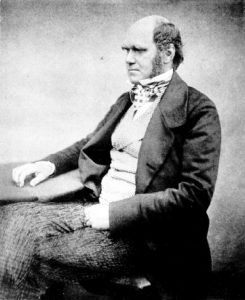
Charles Darwin, aged 51
Charles Darwin
Charles Darwin was born on 12 February 1809 (208 years ago this week), and died on 19 April 1882. Although he studied for a short time in Edinburgh, it was through his close friend and botany professor in Cambridge John Stevens Henslow that he was invited to join Captain Robert FitzRoy as naturalist on HMS Beagle for a round-the-world voyage which began on 27 December 1831 and lasted almost five years until 1836. On the voyage Darwin spent as much time as possible on land investigating geology and making natural history collections including dried plant specimens, while the Beagle surveyed and charted coasts. As is well-known, the voyage took Darwin first to the east coast of South America, round Cape Horn and north to the Galapagos Islands, then to New Zealand, Australia, South Africa, Brazil and home.
Darwin’s Beagle Plants
In studies of the ‘top set’ of Darwin’s plant specimens in the Cambridge University herbarium, Duncan Porter has catalogued the 248 vascular plants which include 16 species of ferns, 35 of monocotyledons and 166 of dicotyledons. These specimens had been entrusted to Henslow to deal with, but the latter’s lack of time and expertise caused him to turn to William Hooker in Glasgow for help. Henslow numbered all the specimens before sending as complete a set as possible to Glasgow, where Hooker in turn enlisted the help of George Walker Arnott. Together they published many vascular plants new to science in the following years. Amongst these were some important novelties such as Berberis darwinii collected by Darwin on Chiloe Island in Chile in 1834 and now a familiar garden plant in Britain.
Darwin’s Bryophytes
Darwin apparently collected relatively few bryophytes, and very little has been published on them. A short list of eight from the Galapagos Islands was published by Hooker’s son Joseph in 1847 following study by the English bryologist William Wilson and these specimens are now in Hooker’s bryophyte herbarium in the Natural History Museum in London. Few of those from other parts of South America have been documented except for Dendroligotrichum dendroides (collected as Polytrichum dendroides) from Tierra del Fuego illustrated and described by William Hooker in his Icones Plantarum in 1836. Duplicates of this specimen, and two other Darwin bryophytes, were found in Arnott’s herbarium in Edinburgh several years ago.
Newly-found Darwin mosses in Edinburgh
In an important new discovery, made in the course of searching for specimens collected by Alexander von Humboldt in Arnott’s herbarium, two unexpected new discoveries have been made of Darwin bryophytes, bearing Henslow’s numbers 436 and 464.
436. Polytrichum magellanicum Hedw., now Polytrichadelphus magellanicus (Hedw.) Mitt., labelled ‘Straits of Terra del Fuego, Darwin per Henslow No. 436’. (E00826655, herb. Arnott). This specimen was collected by Darwin probably in January or February 1833. However, it had been first described by Johannes Hedwig in his Species Muscorum in 1801, based on a collection from the Straits of Magellan made by the French explorer Philibert Commerson in 1767. Remarkably, a duplicate of Commerson’s original specimen is also present in Arnott’s herbarium in E.
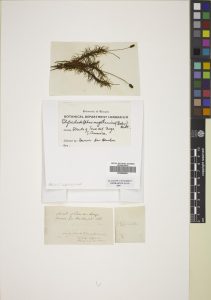
Polytrichadelphus magellanicus
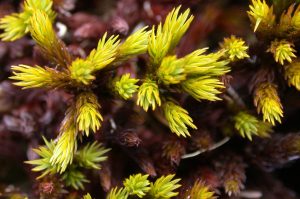
Polytrichadelphus magellanicus, Tierra del Fuego(Photo David Long)
464. Hypnum arbuscula Brid., now Dendrohypopterygium arbuscula (Brid.) Kruijer, labelled ‘Chonos archipelago, Darwin per Revd. J.S. Henslow, No. 464.’ (E00826690, herb. Arnott). This specimen was collected by Darwin when he visited the Chonos Archipelago in Chile in December 1834. As with Darwin’s Polytrichum, this species was also first discovered by Commerson on the Straits of Magellan in 1767, and a duplicate of his specimen is also present in Arnott’s herbarium in E.
Dendrohypopterygium arbuscula is something of a controversial moss as it has recently been moved to a brand new genus Arbusculohypopterygium distinguished primarily on DNA sequences, perhaps the first example of such a genus. It remains to be seen if this will become generally accepted.
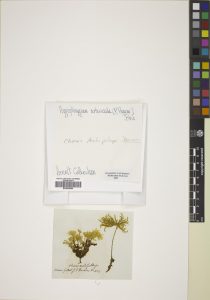
Dendrohypopterygium arbuscula
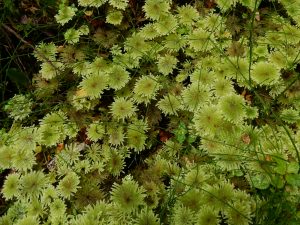
Dendrohypopterygium arbuscula in Chile (photo Oliver Whaley)
How did some of Darwin’s mosses get to Edinburgh?
At the time of the Beagle voyage in the early 1830’s Scotland was one of the world’s leading centres of cryptogamic botany. This was brought about by the appointment of William Jackson Hooker (later Sir William Hooker, Director of Kew) to the Chair of Botany in Glasgow University in 1820 where for 21 years he led the study of mosses, liverworts, ferns and algae, along with his Scottish colleagues Robert Kaye Greville in Edinburgh and George Walker Arnott based in Edinburgh, Fife and Paris. They published extensively and formed a formidable cryptogamic team. All three acquired large herbaria, both from their own field work in Britain and France, and more importantly through gifts and exchange of specimens with botanists and plant collectors worldwide. When Hooker left Glasgow in 1840 he took his very large herbarium with him to Kew, but Greville’s herbarium remained in Edinburgh, and Arnott’s in Glasgow. Fortunately, Hooker was extremely generous with his specimens and gave many duplicates to his friends Arnott and Greville. At later dates Arnott’s herbarium (except for his British collections which went to the Kelvingrove Museum) came to the Royal Botanic Garden, Edinburgh. Through their efforts, and also through the very important acquisition of the herbarium of the Scottish botanist/ explorer Archibald Menzies, Edinburgh now has one of the world’s best historic cryptogamic collections from the late eighteenth and early nineteenth centuries.
Arnott in particular seems to have been especially well-connected with other botanists through his work in Paris where he obtained large numbers of specimens from leading contemporary continental botanists and explorers such as Jean Baptiste Bory de Saint-Vincent, Adolphe-Théodore Brongniart, Jules Paul Benjamin Delessert, Alexander von Humboldt, Adrien-Henri de Jussieu and Carl Sigismund Kunth. It was through Hooker and Arnott’s contact with Henslow in Cambridge that a set of Darwin’s Beagle plants came to Glasgow and later some of these moved to Edinburgh. The Edinburgh collections are still being catalogued, and though much fewer in number than the approximately 250 collections housed in Cambridge, nevertheless duplicates of around one third of the Beagle vascular plants are present in Edinburgh. The two new ‘finds’ of mosses show that this cataloguing may not be complete and more Darwin specimens may yet come to light at RBGE.
David Long

Charles Howie
On Facebook:
Polytrichum magellanicum. Might be of interest to Ron Lewis-Smith. Ron, I remember collecting P. juniperinum and P. alpestre for Royce Longton, and maybe for you as well, Deception and Signy Research Station, Antarctica, 1964-1966